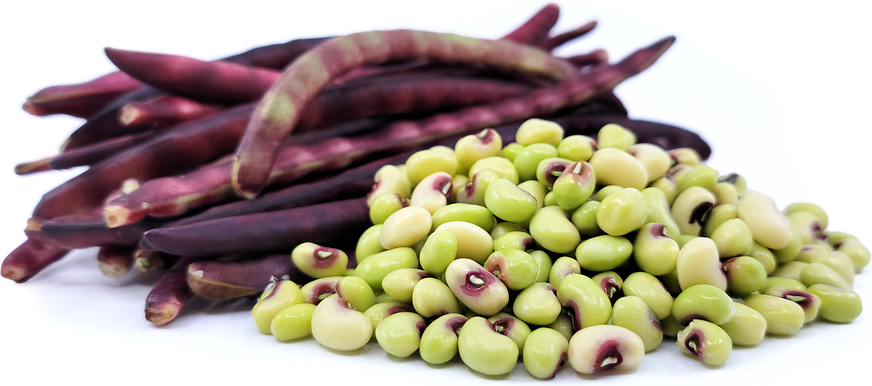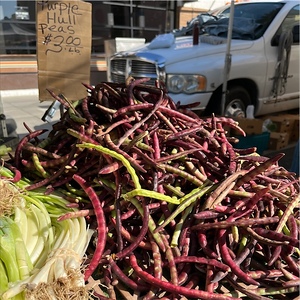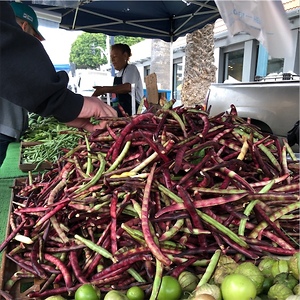


Purple Hull Peas
Estimated Inventory, lb : 0
Description/Taste
Purple Hull peas are encased in slender, elongated pods, averaging 7 to 15 centimeters in length, and each pod typically contains 6 to 13 oblong to kidney-shaped seeds. The pod, also known as the hull, is light green when young and transitions through multiple stages of purple-green, light purple, to deep burgundy as it matures. The consistency of the hull also changes from tender, crisp, and slightly chewy to dry, fibrous, and tough with maturity. Within the hulls, the seeds are smooth with a glossy sheen and are cream-colored to ivory-green with a distinct purple-pink eye. Purple Hull peas can be harvested in multiple stages throughout the growing season and are tender and soft when cooked with a sweet and nutty flavor.
Seasons/Availability
Purple Hull peas are available in the late spring through early fall.
Current Facts
Purple Hull peas, botanically classified as Vigna unguiculate, are a subspecies of the cowpea, which is a legume that belongs to the Fabaceae family. Also known as Pinkeye Purple Hull peas, Pink-Eyed pea, and Southern peas, Purple Hull peas are close cousins to the well-known black-eyed pea but vary slightly in appearance and flavor. There are many varieties of Purple Hull peas that can be found growing on bushes or vining plants, and these plants were first introduced to the United States as an easy-to-grow, inexpensive food source for livestock. The plant’s popularity also increased to human consumption as it was discovered that the crop helped replenish nutrients in the soil for continued agriculture. Purple Hull peas quickly became a staple ingredient in Southern home cooking and are traditionally used in soups, stews, and savory side dishes.
Nutritional Value
Purple Hull peas are an excellent source of fiber, which can help aid in smoother digestion, and are a good source of folate and iron. The legumes also contain some calcium and potassium, which is an electrolyte that can help maintain fluids in the body..
Applications
Purple Hull peas are best suited for cooked applications such as blanching, boiling, steaming, and braising. The pods and seeds can be harvested at multiple stages of maturity, and when young, both the pods and seeds are edible and can be stir-fried as a vegetable, lightly cooked and tossed into salads, or blanched as a simple and fresh side dish. In addition to the pods and seeds, the young leaves of the plant are also edible and can be lightly cooked similarly to spinach. Purple Hull peas are popularly shelled and added to soups, stews, curries, and ragouts, or they can be cooked and served cold in bean salads. In the southern United States, Purple Hull peas can be used in the dish known as hoppin’ John which is a one-pot recipe with rice, a savory sauce, Purple Hull peas, and meat such as pork. In the south, Purple Hull peas are also traditionally cooked with ham or ham hocks for flavor and are served with braised greens as a main dish. Purple Hull peas pair well with herbs such as basil, mint, thyme, sage, and dill, spices such as turmeric, cumin, coriander, and cinnamon, aromatics such as onions, ginger, and garlic, tomatoes, cornbread, hot sauce, and rice. The young pods and seeds will keep up to five days when stored in the refrigerator. Purple Hull peas can also be frozen or dried for extended use.
Ethnic/Cultural Info
In the southern United States, cowpeas such as black-eyed peas and Purple Hull peas are traditional ingredients used in the first dinner of the new year. This annual dinner is believed to bring good luck for the year to come and consists of cooked pork, cornbread, legumes, and greens. Purple Hull peas are also celebrated each June in Emmerson, Arkansas at the annual Purple Hull Pea Festival. This celebration aims to educate visitors on the significance of the Purple Hull pea and holds recipe contests, live dance performances, arts and crafts, and light-hearted games and competitions.
Geography/History
Purple Hull peas originated in Africa, and botanists believe they came to the United States during the slave trade in the 18th and 19th centuries. Used primarily in the southern United States, the pods and seeds were initially eaten by the slaves and were used as a forage crop for livestock, earning them the name “cowpeas.” The seeds eventually grew in popularity in home cooking after the Civil War and became a staple in traditional, southern holiday meals. Outside of the United States, cowpeas are also common crops in Asia, Africa, Australia, South America, and Europe. Harvested seeds and pods are predominately found fresh at local markets and can also be found frozen and dried in specialty grocers and supermarkets.
Recipe Ideas
Recipes that include Purple Hull Peas. One
| World Plates |
|
Hoppin' John and Greens |










